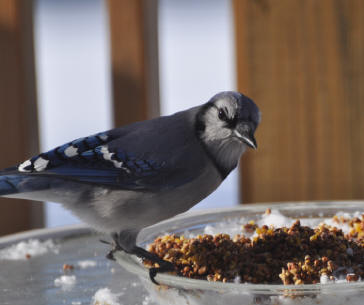 While this fall has given us mild temperatures, before long the cold days and nights of winter will be here. Have you thought about how the birds, bees, and butterflies will manage during the winter chill and how you can help them?
While this fall has given us mild temperatures, before long the cold days and nights of winter will be here. Have you thought about how the birds, bees, and butterflies will manage during the winter chill and how you can help them?
While some birds and pollinators head south for the winter, many of our favorites will remain in the same area where we enjoy them during the spring, summer, and fall. It is important that we care for these critters during the cold dark days of winter so we can continue to enjoy them in warmer weather.
Having native plants in your garden that produce fruits, berries, and seeds is an excellent start towards caring for winter wildlife. Many of our native plants have food that birds can enjoy and survive throughout the winter.
Native perennials such as sunflowers, Rudbeckia (Black-eyed Susan), Echinacea (coneflowers), asters, and Solidago (goldenrod) will have seeds for the birds to eat. Don’t deadhead your flowers in the late fall so the birds can eat the seeds once other food sources are gone. Native shrubs such as Viburnum, holly, or spicebush offer berries for the birds, while native trees like dogwood, mulberry, and serviceberry provide fruits for our feathered friends.
Fall isn’t the best time to realize you haven’t any of these native plants in your garden, but it is an excellent time to plan on adding these to your landscape in the spring so next winter the wildlife in your garden and neighborhood will thrive.
Of course, we often think of bird feeders during the winter months. If you have a feeder, be sure to keep it filled. Birds will become dependent on that food source, so consistency is important. Offering suet in addition to seed gives birds a fat source that is much needed in winter. Suet can be purchased or made from basic items found in most homes, such as peanut butter, cornmeal, oats, and shortening. It makes a great winter craft for young children as they learn to care for winter wildlife.
And don’t forget the water! Even though it isn’t hot outside, birds still need fresh water to drink. Water will freeze as temperatures dip below 32 degrees, so you may want to consider a heater for your birdbath.
Birds aren’t the only wildlife living in our gardens over winter, although they are the most active and the ones we see most frequently. Although some butterflies such as Monarchs and Painted Ladies head south to warmer climates, many butterflies such as Swallowtails will stay in the local garden. These butterflies lay their eggs near their host plant. Some then hibernate nearby in rolled leaves, nooks in trees, or leaf litter, while others will head into a chrysalis for the winter. Knowing what the chrysalis can look like will help us be on the lookout for these hibernating pollinators.
We can help the butterflies by leaving the leaf litter under the trees instead of raking to have a perfectly tidy lawn. Unfortunately, many neighborhoods expect homeowners to rake and clear the leaves each fall. If this is your neighborhood, try to leave at least one part of your landscape a bit wild so pollinators can make use of the fallen leaves. Talking with your neighbors or homeowner’s association may be needed to educate them on why spotlessly tidy landscapes are not preferable.
Another beneficial insect is one of our favorite pollinators: the bee. Like butterflies that remain in the area, bees need a place for nests as well as a safe place to overwinter. Leaf litter, twigs, and logs on the ground are especially helpful for bees to house their nests. Many of our native bees are solitary bees who nest in the ground. Allowing an undisturbed part of your landscape will keep them safe year-round. Be sure to not mulch too deeply since many insects cannot dig or tunnel through a thick layer of mulch. Some bees live in plant stems and will benefit from trimming your pithy or hollow flowering perennial stems to about 12-18". Like the birds, butterflies and bees need water in addition to a safe habitat to overwinter.
By not clearing your lawn and garden in the fall, you are providing an inviting place for these beneficial insects. As with the other seasons of the year, avoiding pesticides and chemicals as much as possible is very important. Consider planting native plants and shrubs that provide nectar such as lilac, Phlox, or lavender just before and right after winter in addition to the native fruits, berries, and seeds they will have in the winter.
One of the joys of winter is watching the birds at our feeders while anticipating the coming of spring with new growth. Helping our pollinators and bird families survive the winter months will not only improve our environment but will increase our enjoyment of the garden and all it has to offer.
Caption: Winter brings challenges to our feathered friends and to our pollinators; we can help by feeding them throughout the season.